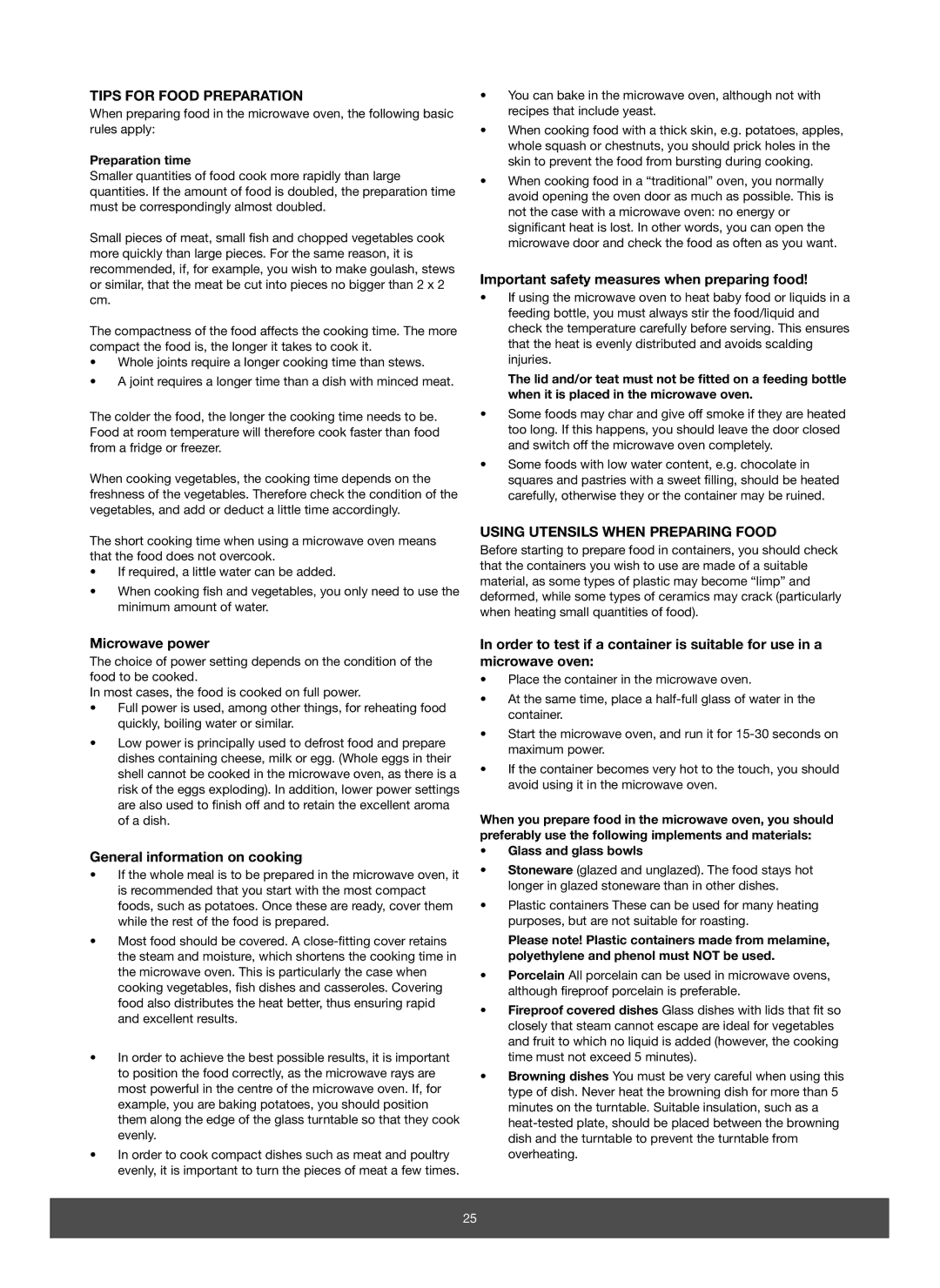
TIPS FOR FOOD PREPARATION
When preparing food in the microwave oven, the following basic rules apply:
Preparation time
Smaller quantities of food cook more rapidly than large quantities. If the amount of food is doubled, the preparation time must be correspondingly almost doubled.
Small pieces of meat, small fish and chopped vegetables cook more quickly than large pieces. For the same reason, it is recommended, if, for example, you wish to make goulash, stews or similar, that the meat be cut into pieces no bigger than 2 x 2 cm.
The compactness of the food affects the cooking time. The more compact the food is, the longer it takes to cook it.
•Whole joints require a longer cooking time than stews.
•A joint requires a longer time than a dish with minced meat.
The colder the food, the longer the cooking time needs to be. Food at room temperature will therefore cook faster than food from a fridge or freezer.
When cooking vegetables, the cooking time depends on the freshness of the vegetables. Therefore check the condition of the vegetables, and add or deduct a little time accordingly.
The short cooking time when using a microwave oven means that the food does not overcook.
•If required, a little water can be added.
•When cooking fish and vegetables, you only need to use the minimum amount of water.
•You can bake in the microwave oven, although not with recipes that include yeast.
•When cooking food with a thick skin, e.g. potatoes, apples, whole squash or chestnuts, you should prick holes in the skin to prevent the food from bursting during cooking.
•When cooking food in a “traditional” oven, you normally avoid opening the oven door as much as possible. This is not the case with a microwave oven: no energy or significant heat is lost. In other words, you can open the microwave door and check the food as often as you want.
Important safety measures when preparing food!
•If using the microwave oven to heat baby food or liquids in a feeding bottle, you must always stir the food/liquid and check the temperature carefully before serving. This ensures that the heat is evenly distributed and avoids scalding injuries.
The lid and/or teat must not be fitted on a feeding bottle when it is placed in the microwave oven.
•Some foods may char and give off smoke if they are heated too long. If this happens, you should leave the door closed and switch off the microwave oven completely.
•Some foods with low water content, e.g. chocolate in squares and pastries with a sweet filling, should be heated carefully, otherwise they or the container may be ruined.
USING UTENSILS WHEN PREPARING FOOD
Before starting to prepare food in containers, you should check that the containers you wish to use are made of a suitable material, as some types of plastic may become “limp” and deformed, while some types of ceramics may crack (particularly when heating small quantities of food).
Microwave power
The choice of power setting depends on the condition of the food to be cooked.
In most cases, the food is cooked on full power.
•Full power is used, among other things, for reheating food quickly, boiling water or similar.
•Low power is principally used to defrost food and prepare dishes containing cheese, milk or egg. (Whole eggs in their shell cannot be cooked in the microwave oven, as there is a risk of the eggs exploding). In addition, lower power settings are also used to finish off and to retain the excellent aroma of a dish.
General information on cooking
•If the whole meal is to be prepared in the microwave oven, it is recommended that you start with the most compact foods, such as potatoes. Once these are ready, cover them while the rest of the food is prepared.
•Most food should be covered. A
•In order to achieve the best possible results, it is important to position the food correctly, as the microwave rays are most powerful in the centre of the microwave oven. If, for example, you are baking potatoes, you should position them along the edge of the glass turntable so that they cook evenly.
•In order to cook compact dishes such as meat and poultry evenly, it is important to turn the pieces of meat a few times.
In order to test if a container is suitable for use in a microwave oven:
•Place the container in the microwave oven.
•At the same time, place a
•Start the microwave oven, and run it for
•If the container becomes very hot to the touch, you should avoid using it in the microwave oven.
When you prepare food in the microwave oven, you should preferably use the following implements and materials:
•Glass and glass bowls
•Stoneware (glazed and unglazed). The food stays hot longer in glazed stoneware than in other dishes.
•Plastic containers These can be used for many heating purposes, but are not suitable for roasting.
Please note! Plastic containers made from melamine, polyethylene and phenol must NOT be used.
•Porcelain All porcelain can be used in microwave ovens, although fireproof porcelain is preferable.
•Fireproof covered dishes Glass dishes with lids that fit so closely that steam cannot escape are ideal for vegetables and fruit to which no liquid is added (however, the cooking time must not exceed 5 minutes).
•
25
